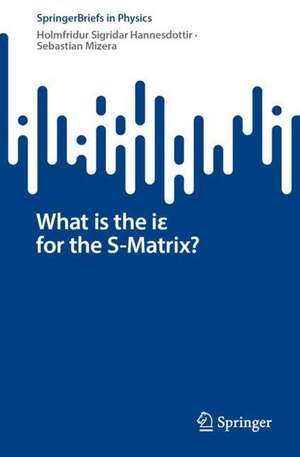What is the iε for the S-matrix?: SpringerBriefs in Physics
Autor Holmfridur Sigridar Hannesdottir, Sebastian Mizeraen Limba Engleză Paperback – 2 ian 2023
Din seria SpringerBriefs in Physics
-
 Preț: 476.95 lei
Preț: 476.95 lei -
 Preț: 381.00 lei
Preț: 381.00 lei -
 Preț: 200.36 lei
Preț: 200.36 lei -
 Preț: 444.74 lei
Preț: 444.74 lei -
 Preț: 394.99 lei
Preț: 394.99 lei -
 Preț: 346.92 lei
Preț: 346.92 lei -
 Preț: 311.69 lei
Preț: 311.69 lei - 17%
 Preț: 359.19 lei
Preț: 359.19 lei -
 Preț: 477.72 lei
Preț: 477.72 lei -
 Preț: 378.92 lei
Preț: 378.92 lei -
 Preț: 377.18 lei
Preț: 377.18 lei - 15%
 Preț: 463.85 lei
Preț: 463.85 lei -
 Preț: 379.86 lei
Preț: 379.86 lei -
 Preț: 378.92 lei
Preț: 378.92 lei - 15%
 Preț: 461.73 lei
Preț: 461.73 lei -
 Preț: 413.07 lei
Preț: 413.07 lei -
 Preț: 376.59 lei
Preț: 376.59 lei -
 Preț: 344.53 lei
Preț: 344.53 lei -
 Preț: 477.94 lei
Preț: 477.94 lei -
 Preț: 475.06 lei
Preț: 475.06 lei -
 Preț: 377.73 lei
Preț: 377.73 lei -
 Preț: 345.89 lei
Preț: 345.89 lei -
 Preț: 378.12 lei
Preț: 378.12 lei - 15%
 Preț: 464.18 lei
Preț: 464.18 lei -
 Preț: 376.80 lei
Preț: 376.80 lei -
 Preț: 376.22 lei
Preț: 376.22 lei -
 Preț: 376.80 lei
Preț: 376.80 lei -
 Preț: 376.80 lei
Preț: 376.80 lei -
 Preț: 409.43 lei
Preț: 409.43 lei -
 Preț: 374.46 lei
Preț: 374.46 lei -
 Preț: 377.57 lei
Preț: 377.57 lei -
 Preț: 380.84 lei
Preț: 380.84 lei - 20%
 Preț: 387.05 lei
Preț: 387.05 lei -
 Preț: 377.73 lei
Preț: 377.73 lei -
 Preț: 380.07 lei
Preț: 380.07 lei -
 Preț: 475.44 lei
Preț: 475.44 lei -
 Preț: 346.23 lei
Preț: 346.23 lei -
 Preț: 343.72 lei
Preț: 343.72 lei -
 Preț: 349.80 lei
Preț: 349.80 lei - 15%
 Preț: 463.53 lei
Preț: 463.53 lei -
 Preț: 376.04 lei
Preț: 376.04 lei - 15%
 Preț: 462.38 lei
Preț: 462.38 lei -
 Preț: 475.65 lei
Preț: 475.65 lei -
 Preț: 375.07 lei
Preț: 375.07 lei -
 Preț: 346.27 lei
Preț: 346.27 lei -
 Preț: 450.33 lei
Preț: 450.33 lei -
 Preț: 376.22 lei
Preț: 376.22 lei -
 Preț: 380.07 lei
Preț: 380.07 lei -
 Preț: 347.80 lei
Preț: 347.80 lei -
 Preț: 376.22 lei
Preț: 376.22 lei
Preț: 381.00 lei
Nou
Puncte Express: 572
Preț estimativ în valută:
72.91€ • 75.66$ • 60.94£
72.91€ • 75.66$ • 60.94£
Carte tipărită la comandă
Livrare economică 17-31 martie
Preluare comenzi: 021 569.72.76
Specificații
ISBN-13: 9783031182570
ISBN-10: 303118257X
Pagini: 165
Ilustrații: VI, 165 p. 39 illus., 37 illus. in color.
Dimensiuni: 155 x 235 mm
Greutate: 0.25 kg
Ediția:1st ed. 2022
Editura: Springer International Publishing
Colecția Springer
Seria SpringerBriefs in Physics
Locul publicării:Cham, Switzerland
ISBN-10: 303118257X
Pagini: 165
Ilustrații: VI, 165 p. 39 illus., 37 illus. in color.
Dimensiuni: 155 x 235 mm
Greutate: 0.25 kg
Ediția:1st ed. 2022
Editura: Springer International Publishing
Colecția Springer
Seria SpringerBriefs in Physics
Locul publicării:Cham, Switzerland
Cuprins
1. Introduction.- 2. Unitarity implies anomalous thresholds.- 3. Primer on the analytic S-matrix 4.- Singularities as classical saddle points.- 5. Branch cut deformations.- 6. Glimpse at generalized dispersion relations.- 7. Fluctuations around classical saddle points.- 8. Conclusion Appendix. Review of Schwinger parametrization.
Notă biografică
Dr. Holmfridur Sigridar Hannesdottir is a member of the School of Natural Sciences at the Institute for Advanced Study in Princeton, NJ. She received a Ph.D. in physics from Harvard University, after completing a B.Sc. in physics from the University of Iceland. Her work focuses on theoretical aspects of quantum field theories, including the study of infrared divergences in gauge theories and constraining the analytic structure of Feynman integrals.
Dr. Sebastian Mizera is a long-term member at the Institute for Advanced Study in Princeton, NJ. He graduated from the University of Cambridge with a bachelor's degree in natural sciences and a master's in mathematics. He obtained a Ph.D. in theoretical physics from the Perimeter Institute and the University of Waterloo in Canada. Dr. Mizera's work focuses on the interconnections between scattering amplitudes in quantum field theories and the mathematics of algebraic geometry and topology.
Dr. Sebastian Mizera is a long-term member at the Institute for Advanced Study in Princeton, NJ. He graduated from the University of Cambridge with a bachelor's degree in natural sciences and a master's in mathematics. He obtained a Ph.D. in theoretical physics from the Perimeter Institute and the University of Waterloo in Canada. Dr. Mizera's work focuses on the interconnections between scattering amplitudes in quantum field theories and the mathematics of algebraic geometry and topology.
Caracteristici
Provides a pedagogical introduction to the analytic properties of the S-matrix Reviews the rich literature on singularities of scattering amplitudes Presents a new prescription for analytically continuing Feynman integrals to complex kinematics
